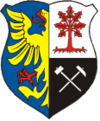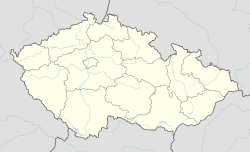Orlová
| Orlová Orłowa |
|||
|---|---|---|---|
| Town | |||

Downtown Orlová-Lutyně
|
|||
|
|||
| Location in the Czech Republic | |||
| Coordinates: 49°50′50″N 18°25′6″E / 49.84722°N 18.41833°E | |||
| Country | Czech Republic | ||
| Region | Moravian-Silesian | ||
| District | Karviná | ||
| First mentioned | 1223 | ||
| Town rights | 1922 | ||
| Town parts | |||
| Government | |||
| • Mayor | Ing. Tomáš Kuča (ČSSD) | ||
| Area | |||
| • Total | 24.67 km2 (9.53 sq mi) | ||
| Elevation | 215 m (705 ft) | ||
| Population (2012) | |||
| • Total | 30,988 | ||
| • Density | 1,300/km2 (3,300/sq mi) | ||
| Postal code | 735 11 to 735 14 | ||
| Website | http://www.mesto-orlova.cz/ | ||
Orlová (Czech pronunciation: [ˈorlovaː]; Polish: Orłowa ; German: Orlau) is a town in the Karviná District, Moravian-Silesian Region, Czech Republic. It lies in the historical region of Cieszyn Silesia.
The name is most probably possessive in origin, derived from the personal name Orel (Czech) (Orzeł in Polish), the same as eagle in English, although it may also be of topographic origins.
According to legend, Mieszko, a Silesian duke from the lower branch of the Piast dynasty, went hunting with his pregnant wife, Ludmiła. As they rested upon a hill, an eagle suddenly took flight, frightening the couple. The eagle dropped his prey, which fell to earth near them. Ludmiła prematurely gave birth to her child, Kazimierz. The couple, seeing a sign from God in this incident, founded a chapel on that spot and later named the subsequent settlement after the eagle (Polish: orzeł, Czech: orel). Thus, it is not clear when the settlement was really founded; however, it was first mentioned in a document of Pope Gregory IX issued on 7 December 1227 for Benedictine abbey in Tyniec as Orlova. Around 1268 a separate but dependent from Tyniec Benedictine monastery was founded.
Politically it belonged then to the Duchy of Opole and Racibórz and the Castellany of Cieszyn, which was in 1290 formed in the process of feudal fragmentation of Poland into the Duchy of Teschen, ruled by a local branch of Silesian Piast dynasty. In 1327 the duchy became a fee of the Kingdom of Bohemia, which after 1526 became a part of the Habsburg Monarchy.
...
Wikipedia



